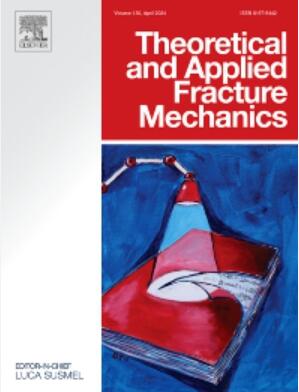Fracture loads of ISRM-suggested notched semi-circular bend rock specimens using finite fracture mechanics
IF 5.6
2区 工程技术
Q1 ENGINEERING, MECHANICAL
引用次数: 0
Abstract
The International Society for Rock Mechanics (ISRM) recommends notched Brazilian semi-circular bend specimen (NSCB) to measure fracture parameters of rocks. However, the testing accuracy is limited by the mechanical processing precision of the specimen, especially the notch tip, thus the testing results of fracture parameter is often strongly affected by the curvature radius of the notch tip. Moreover, traditional fracture mechanics methods find it challenging to quantify the effect of notch geometry on fracture properties. This paper proposes a semi-analytical method based on finite fracture mechanics (FFM) to predict the effects of geometric parameters of the notch and specimen on the critical load of U-notched semi-circular bend specimen (U-NSCB). First, the stress fields at the notch tip of U-NSCB specimen and the stress intensity factor (SIF) at the virtual crack tip ahead of the U-notch were determined using finite element simulations combined with the contour integral method, and a relationship between the mechanical properties of U-NSCB specimen and the geometry of the U-notch was established to characterize the effects caused by changes in notch geometry. Second, a semi-analytical solution was developed using the coupled FFM criterion to predict the critical load at crack initiation for U-NSCB specimens. Finally, three-point bending tests were conducted on U-NSCB specimens made of Fangshan marble (FM) with different notch lengths and curvature radii to validate the effectiveness and accuracy of the semi-analytical method. The inherent fracture toughness of the marble was also inversely obtained based on the FFM prediction results. The research findings showed that the predictions from the FFM with point stress criterion were more accurate than those from the FFM with line stress criterion, with a maximum deviation of 6.81% from the experimental results. The proposed FFM semi-analytical method helps to improve testing accuracy of the NSCB method and offers a new approach for predicting the critical load of other specimens with finite size.
基于有限断裂力学的isrm建议缺口半圆弯曲岩石试件断裂载荷
国际岩石力学学会(ISRM)推荐使用缺口巴西半圆弯曲试样(NSCB)来测量岩石的断裂参数。然而,测试精度受到试样特别是缺口尖端的机械加工精度的限制,因此断裂参数的测试结果往往受到缺口尖端曲率半径的强烈影响。此外,传统的断裂力学方法难以量化缺口几何形状对断裂性能的影响。提出了一种基于有限断裂力学(FFM)的半解析方法来预测缺口和试件几何参数对u型缺口半圆弯曲试件临界载荷的影响。首先,采用有限元模拟结合轮廓积分法确定U-NSCB试样缺口尖端的应力场和u型缺口前方虚拟裂纹尖端的应力强度因子,建立U-NSCB试样力学性能与u型缺口几何形状的关系,表征缺口几何形状变化对U-NSCB试样力学性能的影响。其次,利用耦合FFM准则推导了U-NSCB试件裂纹起裂临界载荷的半解析解。最后,对不同缺口长度和曲率半径的房山大理石U-NSCB试件进行三点弯曲试验,验证了半解析方法的有效性和准确性。基于FFM预测结果反演了大理岩的固有断裂韧性。研究结果表明,采用点应力准则的FFM预测结果比采用线应力准则的FFM预测结果更准确,与实验结果的最大偏差为6.81%。所提出的FFM半解析方法有助于提高NSCB方法的测试精度,并为其他有限尺寸试件的临界载荷预测提供了一种新的方法。
本文章由计算机程序翻译,如有差异,请以英文原文为准。
求助全文
约1分钟内获得全文
求助全文
来源期刊

Theoretical and Applied Fracture Mechanics
工程技术-工程:机械
CiteScore
8.40
自引率
18.90%
发文量
435
审稿时长
37 days
期刊介绍:
Theoretical and Applied Fracture Mechanics'' aims & scopes have been re-designed to cover both the theoretical, applied, and numerical aspects associated with those cracking related phenomena taking place, at a micro-, meso-, and macroscopic level, in materials/components/structures of any kind.
The journal aims to cover the cracking/mechanical behaviour of materials/components/structures in those situations involving both time-independent and time-dependent system of external forces/moments (such as, for instance, quasi-static, impulsive, impact, blasting, creep, contact, and fatigue loading). Since, under the above circumstances, the mechanical behaviour of cracked materials/components/structures is also affected by the environmental conditions, the journal would consider also those theoretical/experimental research works investigating the effect of external variables such as, for instance, the effect of corrosive environments as well as of high/low-temperature.
 求助内容:
求助内容: 应助结果提醒方式:
应助结果提醒方式:


